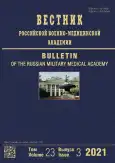Navigation and design of adrenal surgery with the aid of computed tomography
- Authors: Blyumina S.G.1, Romashchenko P.N.1, Zheleznyak I.S.1
-
Affiliations:
- Military Medical Academy named after S.M. Kirov of the Ministry of Defense of the Russian Federation
- Issue: Vol 23, No 3 (2021)
- Pages: 41-48
- Section: Clinical trials
- URL: https://journals.rcsi.science/1682-7392/article/view/74774
- DOI: https://doi.org/10.17816/brmma74774
- ID: 74774
Cite item
Abstract
This study evaluated the possibilities of designing a safe access for adrenalectomy using preoperative computed tomography navigation. The outcomes of surgical interventions in 1.457 patients with diseases of the adrenal glands requiring surgery were examined, among which 1.209 patients underwent endovideosurgery with a follow-up period of up to 20 years. Of the total number of patients, 418 were included in the analysis for the preoperative design of access for adrenalectomy using computed tomography navigation. This cohort was conditionally divided into a retrospective group (n = 157) and a prospective group (n = 261). After a comprehensive examination of patients with adrenal formations, according to the algorithm developed at the department, an integral assessment of the leading anthropometric (body mass index and physique form) and computed tomography criteria (i.e., formation diameter; tumor synthopia with respect to the walls of the inferior vena cava; length of the central adrenal vein and the place of its confluence with the lower hollow and renal veins; location of the tumor relative to the lower vein of the right lobe of the liver, as well as relative to the gate of the right kidney; location near the aortorenal vascular triangle; gate of the left kidney; and spleen vessels) allows us to justify the selection of a rational technique and the volume of the surgical treatment. Among endovideosurgical interventions, adrenalectomy from a retroperitoneoscopic access has a significant advantage because it causes the least trauma and short operating time in comparison with laparoscopic access. No intraoperative complications occurred, taking into account the planning of the access option and technique for performing adrenalectomy. Expected complications that may have occurred during adrenalectomy were damage to the central vein of the adrenal glands, renal and spleen vessels, and inferior vena cava and intraoperative blood loss. In general, an increase in operating time directly depends on the peculiarities of the location of the tumor in the adrenal gland, which can be evaluated in detail using preoperative computed tomography, making it possible to reasonably use endovideosurgical or open adrenalectomy alternatives and thus reliably improving the immediate treatment outcomes of the patients.
Full Text
##article.viewOnOriginalSite##About the authors
Sofya G. Blyumina
Military Medical Academy named after S.M. Kirov of the Ministry of Defense of the Russian Federation
Author for correspondence.
Email: sonechka.bliumina@yandex.ru
ORCID iD: 0000-0001-7028-2347
SPIN-code: 3612-5052
candidate of medical sciences
Russian Federation, Saint PetersburgPavel N. Romashchenko
Military Medical Academy named after S.M. Kirov of the Ministry of Defense of the Russian Federation
Email: romashchenko@rambler.ru
ORCID iD: 0000-0001-8918-1730
SPIN-code: 3850-1792
doctor of medical sciences, professor
Russian Federation, Saint PetersburgIgor S. Zheleznyak
Military Medical Academy named after S.M. Kirov of the Ministry of Defense of the Russian Federation
Email: igzh@bk.ru
ORCID iD: 0000-0001-7383-512X
SPIN-code: 1450-5053
doctor of medical sciences
Russian Federation, Saint PetersburgReferences
- Romashchenko PN, Zheleznyak IS, Maistrenko NA, et al. Designing access for adrenalectomy using computer-tomographic 3D modeling. Diagnostic Radiology and Radiotherapy. 2021;12(1):68–74 (In Russ.) doi: 10.22328/2079-5343-2021-12-1-68-74
- Walz MK Minimally invasive adrenal gland surgery. Transperitoneal or retroperitoneal approach? Der Chirurg. 2012;83(6):536–545. doi: 10.1007/s00104-011-2194-5
- Heger P, Probst P, Huttner FJ, et al. Evaluation of open and minimally invasive adrenalectomy: a systematic review and network meta-analysis. World Journal of Surgery. 2017;41(1):2746–2757. doi: 10.1007/s00268-017-4095-3
- Hupe MC, Imkamp F, Merseburger AS Minimally invasive approaches to adrenal tumors: an up-to-date summary including patient position and port placement of laparoscopic, retroperitoneoscopic, robot-assisted and single-site adrenalectomy. Current Opinion in Urology. 2017;27(1):56–61. doi: 10.1097/MOU.0000000000000339
- Maistrenko NA, Fomin NF, Romashchenko PN, et al. Clinical and anatomical substantiation of approaches and techniques of endovideosurgical adrenalectomy. Bulletin of Surgery named after. II. Grekov. 2002;161(3):21–28 (In Russ.).
- Emelyanov SI, Veredchenko VA, Mitichkin AE. Ispol’zovanie trjohmernoj komp’juternoj tomografii v planirovanii laparoskopicheskoj adrenaljektomii Bulletin of Experimental and Clinical Surgery. 2008;1(1):13–16 (In Russ.).
- Azoury SC, Nagarajan N, Young A, et al. Computed tomography in the management of adrenal tumors: does size still matter? Journal of Computer Assisted Tomography. 2017;41(4):628–632. doi: 10.1097/RCT.0000000000000578
- Rowe SP, Lugo-Fagundo C, Ahn H, et al. What the radiologist needs to know: the role of preoperative computed tomography in selection of operative approach for adrenalectomy and review of operative techniques. Abdominal Radiology. 2019;44(1):140–153. doi: 10.1007/s00261-018-1669-y
- Souzaki R, Kinoshita Y, Ieiri S, et al. Preoperative surgical simulation of laparoscopic adrenalectomy for neuroblastoma using a three-dimensional printed model based on preoperative CT-Images. Journal of Pediatric Surgery. 2015;50(12):2112–2115. doi: 10.1016/j.jpedsurg.2015.08.037
- Alesina PF. Retroperitoneal adrenalectomy — learning curve, practical tips and tricks, what limits wider uptake. Gland Surgery. 2019;8(1):36–40. doi: 10.21037/gs.2019.03.11
- Mihai R, Donatini G, Vidal O, et al. Volume-outcome correlation in adrenal surgery — an ESES consensus statement. Langenbeck’s archives of surgery. 2019;404(7):795–806. doi: 10.1007/s00423-019-01827-5
- Zonca P, Peterja M, Varra P, et al. The risk of retroperitoneoscopic adrenalectomy. Rozhl Chir. 2017;96(3):130–133.
- Lorenz K, Langer P, Niederle B, et al. Surgical therapy of adrenal tumors: Guidelines from the German Association of Endocrine Surgeons (CAEK). Langenbeck’s Archives of Surgery. 2019;404(4):385–401. doi: 10.1007/s00423-019-01768-z
- Madani A, Lee JA Surgical approaches to the adrenal gland. The Surg Clin North Am. 2019;99(4):773–791. doi: 10.1016/j.suc.2019.04.013
- Kostek M, Aygun N, Uludag M, et al. Laparoscopic approach to the adrenal masses: single-center experience of five years. Sisli Etfal Hastan Tip Bul. 2020;54(1):52–57. doi: 10.14744/SEMB.2019.40225
- Maistrenko NA, Romashchenko PN, Lysanyuk MV Optimization of endovideosurgical adrenalectomy. Abstracts of the 12th Congress of the Russian Society of Endoscopic Surgeons. Endoscopic Surgery. Moscow: 2009;146–147 (In Russ.).
- Christakis I, Ng CS, Chen C, et al. Operation duration and adrenal gland size, but not BMI are correlated with complication rate for posterior retroperitoneoscopic adrenalectomy for benign diseases. Surgery. 2019;165(3):637–643. doi: 10.1016/j.surg.2018.09.044
Supplementary files










